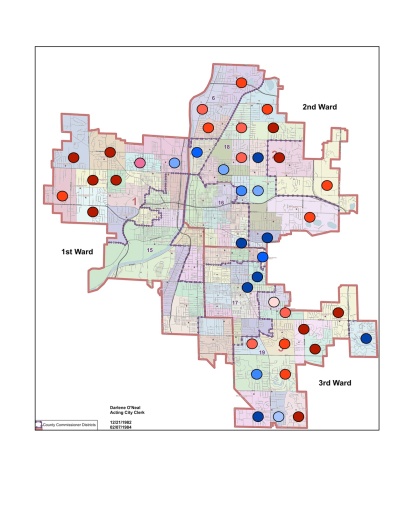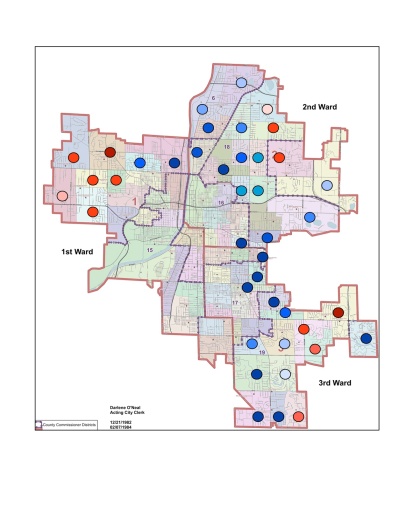As sure as robin in spring, the hiring of Census workers can only mean one thing: time to again contemplate carving up the political landscape. And really, nothing is quite so delicious. Especially in Michigan with likely loss of at least one congressional seat. A whole new set of winners and losers is ready to be created.
And of the first maps out, is that from Menhen, at Swing State Project. There’s plenty of discussion on the proposal on state-wide aspects, here. For those on the west side of the state, things get especially interesting. The second district (Hoekstra) becomes the Ehlers seat, with urbanized Kent County (Grand Rapids, Wyoming, Kentwood, East Grand Rapids) replacing Ottawa County. Meanwhile, the Third now becomes the “Hoekstra” home, packing together Ottawa, Allegan, Van Buren and about 40 percent of Kent).
Even were the arrangement not prove workable, it nonetheless can be considered as very useful sort of thought experiment.
 Here is how the district gets drawn:
Here is how the district gets drawn:

If the map looks familiar, it should: this is essentially the same redistricting solution used for assigning State Senate seats in he county. So the 29th (Bill Hardiman, R-Kentwood) includes Grand Rapids, Kentwood, Cascade and some exurb/rural townships to the east. The rest of Kent County becomes the 28th (Mark Jansen, R-Gaines) surrounding the 29th like a “C.” Same topology here in the congressional redesign.
As a Kent County partisan this division can look problematic, especially as the region wrestles with issues of development and of educational equality. These are contentious enough as it is; this political division could serve to increase the distances between cities and suburbs in ways that work against its best interest. Indeed, practically speaking, this may be the real point of difficulty for any such plan: both parties maintain real interest in controlling their own destiny, as they have to date. Thus, the pressure will be to vote for a unified Kent County.
Muskegon and Grand Rapids go together
This is perhaps the most obvious direction that redistricting will take if the Democratic party can control the process. A District with both Muskegon and Grand Rapids in it would raise the core urban issues with much greater force. Minorities gain voice. The experience of representation in Grand Rapids demonstrates how urban issues can sway even otherwise conservative representatives. That these two cities are also two bastions of Democratic strength in the region makes this a natural combination for Democrats.
Strength in numbers for Kent County
At first, the division of Kent County looks counter-intuitive to the region’s interest. Yet, as in the State Senate such an arrangement can potentially serve to expand and extend the region’s clout. This will be its great appeal to those engaged in regional planning. The risk is no less obvious: potentially the County could not be represented at all, and civic leadership would then have to depend on outsiders, an awkward situation if for no other reason than pride.
A look at raw numbers suggests that this worst case scenario may not be as likely as some fear.
In a Grand Rapids – Muskegon district, Kent County would continue to provide something close to two-thirds of the total vote, thereby making the region a natural home base. For the new 3rd, things are a little more dicey. Suburban/exurban Kent County would contribute approximately 40% of the base to the new district, and more importantly be home to some of the deepest Party pockets. The centripetal pull of fundraising will keep any candidate close to the heart of Kent County. And likely as not, also be a resident , as well.
likely provide a candidate for the seat. The result for regional planning would be two members of congress tightly identified with the interests of Kent County. This would be an improvement from the present situation.
In terms of selling redistricting plan such as this, the potential doubled representation from Kent County will rank high.
The 86th lives
On the Republican side, the plan would mirror the present division in the Kent County party, between the social conservatives on the west — the party of the Lands, Voorhees, and generally Ottawa County; and the economic, leaning to libertarian conservatives of the east — this is the party of Ada and Amway, and also of Justin Amash. As in te Democratic Party, the division between east and west is present and active, here best thought of as that of Ada and Grandville.
The present weakened state of the Kent County party not only has left a number of local Republican party members shaking their heads, but has been increasing the rumblings below deck. As the national party tilts toward and ideological purity, the battle will almost certainly intensify between the economic and the social conservatives. This division is already present in State House 86, encompassing the social conservatism of Walker and the economic leadership of Ada Township. The redistricted 3rd invites a similar sort of battle line. A civil war among the GOP is not necessarily in the Democrats best interest; such a civil war is as likely to result in the ideological pure winning. A region where the pure win promises less in terms of the deelopment the region requires for its long-term growth.
Notes on Weaknesses
Such a plan as this is bold, but some obvious drawbacks do need to be mentioned.
- A district that cuts out the money powers from downtown is going to have some difficulty getting through. Perhaps the region is at the cusp of really going metropolitan, but for many there still remains the hegemonic ideal: a unified political-social-philanthropic culture. This sense of the region as a region extends across party lines. It is not at all obvious that even a Democrat in the 29th State Senate seat would go along with a plan that fractures the congressional seat.
- Redistricting plans are better when they follow existing patterns of political or socio-economic organization. What ever the virtues the partisan gains from a redistrciting plan such as this, it remains far more useful to have the congressional district and the metrolpolitan area(s) correspond with one another. The questions of recovery and development that are likely to be ours in West Michigan ask for pragmatic leadership.
Thus, while a Muskegon-Grand Rapids axis makes sense, being part of the same SMSA (Standard Metropolitan Statistical Area). The northern lakeshore counties share a different set of problems. Representation that follows basic economic interests is simply going to be more efficient in helping those interests and communities deal with Washington.
- Lastly, on practical terms, a revised Muskegon-Grand Rapids district ought to naturally incude Newaygo. Newaygo has become part of the west Michigan metro area. For the same reason, Ionia ought also to be part of a west Michigan congressional district.
The plan from Swing State Project is not the first to imagine the shape of things to come, but it does begin a useful conversation on how we can better structure our communities for better representation, and continued economic development.
Filed under: Elections, Politics, Grand Rapids, Muskegon, Newaygo, Redistricting
 This is a map that will drive many crazy in the GOP. As the red dots indicate, Gov. Snyder won decisively in the 76th District. Eleven precincts gave him at least a 20 point margin (and some came close to a full 40; a 70-30 split). The places where the party dominated on the SE side, the NE fringe (with the Riverside neighborhood tossed in) demonstrate why the district has the shape that it does. They were supposed to win in the off year, except, they didn’t. The gerrymander failed.
This is a map that will drive many crazy in the GOP. As the red dots indicate, Gov. Snyder won decisively in the 76th District. Eleven precincts gave him at least a 20 point margin (and some came close to a full 40; a 70-30 split). The places where the party dominated on the SE side, the NE fringe (with the Riverside neighborhood tossed in) demonstrate why the district has the shape that it does. They were supposed to win in the off year, except, they didn’t. The gerrymander failed. Precincts that were in the GOP column are now in her’s and what is more, they are there in decisive shape, with her winning with twenty percent margins (look at precinct 2-42, or precincts 3-77, and 3-59). Even in precincts where the Governor won big, the Brinks campaign tightened the margin (look at precinct 1-6).
Precincts that were in the GOP column are now in her’s and what is more, they are there in decisive shape, with her winning with twenty percent margins (look at precinct 2-42, or precincts 3-77, and 3-59). Even in precincts where the Governor won big, the Brinks campaign tightened the margin (look at precinct 1-6).
 Here is how the district gets drawn:
Here is how the district gets drawn:
